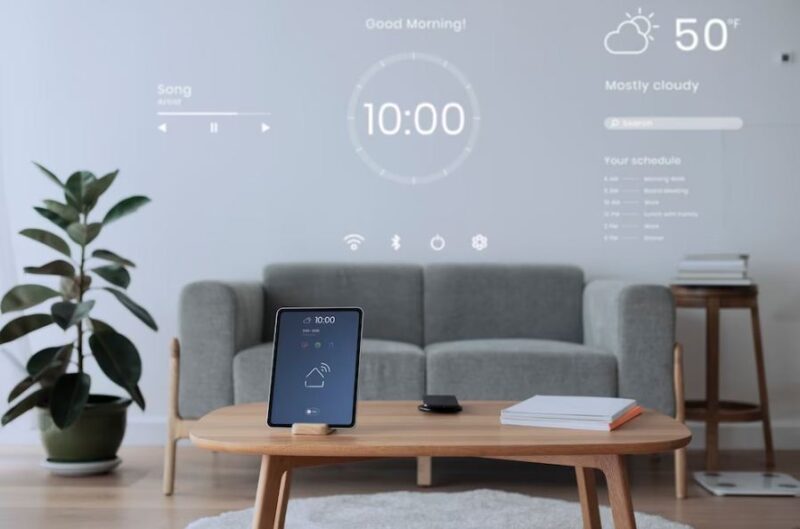Smart thermostats are becoming an increasingly popular option for households looking to control the temperature in their homes. These devices allow you to program your heating and cooling system to automatically adjust to your preferred temperature at different times of the day. You can click here to learn more about the best thermostat temperature settings for your Arizona home.
We asked the professionals at American Home Water and Air to talk with us about the pros and cons of using a smart thermostat so that we can help you determine if it’s the right choice for you. Here’s what they told us.
Pros of a Smart Thermostat
There are many advantages to upgrading to a smart thermostat. Let’s take a look at some of them.
Energy Savings
One of the biggest advantages of a smart thermostat is that it can help reduce your energy costs. This is accomplished by setting the thermostat to adjust to different temperatures at various times of the day. For instance, you may have one temperature for when you are asleep, another for when you are away, and another for when you are home. You might also adjust temperatures for when it is cooler during certain times of the day.
Increased Comfort
With a smart thermostat, you can set the temperature in your home to your preferred level, regardless of the time of day. This means that you can come home to a warm and comfortable house after a long day at work, even if it’s the middle of winter.
Easy to Use
Smart thermostats are designed to be user-friendly, making it easy for you to program and control the temperature in your home. Many models even come with touchscreen displays, making it simple to navigate and change the settings.
Increased Convenience
With a smart thermostat, you no longer have to worry about manually adjusting the temperature in your home. You can set it and forget it, knowing that your heating and cooling system will automatically adjust to your preferred temperature when you need it.
Cons of a Smart Thermostat
Though there are many pros to upgrading to a smart thermostat, there are also some drawbacks. Here are some of the cons:
Initial Cost
While smart thermostats can help you save money on your energy bill in the long run, the initial cost can be high. The cost of purchasing and installing a smart thermostat can be several hundred dollars, which may be a barrier for some households.
Complexity
While many smart thermostats are designed to be user-friendly, they can still be complex to set up and use. This can be particularly true for households that have multiple zones or a complex heating and cooling system.
Maintenance
Like any device, smart thermostats can develop issues or stop working over time. In these cases, you may need to call in a professional to diagnose and repair the problem, which can be time-consuming and costly.
Limited Flexibility
While a smart thermostat can be set to adjust the temperature in your home at various times of the day, it may not be able to accommodate all of your needs. For example, if you have a variable work schedule, you may need to manually adjust the temperature when you’re home or away.
Does A Smart Thermostat Require a Wi-Fi Connection?
A smart thermostat can work remotely, meaning that you can control it from a remote location, such as your smartphone or tablet. This feature allows you to adjust the temperature in your home even when you’re away, so you can come home to a warm and comfortable house, for example.
Whether a smart thermostat requires Wi-Fi or not depends on the model and the manufacturer. Some smart thermostats connect to your home internet’s wireless system, allowing you to control them through a mobile app or a web interface. Others use a proprietary wireless protocol that doesn’t require an internet connection.
To use the remote-control features of a Wi-Fi-enabled smart thermostat, you’ll need a strong and stable Wi-Fi connection. This means that you may need to invest in a better router or a Wi-Fi extender if you have weak or spotty Wi-Fi coverage in your home.
In general, Wi-Fi smart thermostats offer more advanced features and greater flexibility than non-Wi-Fi models, but they also require a more robust Wi-Fi network to work effectively. If you’re considering a smart thermostat with remote control capabilities, be sure to carefully consider your Wi-Fi setup and compatibility with your home network before making a purchase.
What Maintenance Does a Smart Thermostat Require?
Smart thermostats are relatively low-maintenance devices, but they still require some routine upkeep to ensure that they work properly. Here are some of the most common maintenance tasks that you should perform on your smart thermostat:
Battery Replacement
If your smart thermostat runs on batteries, you should check the battery level regularly and replace them as needed. Most manufacturers recommend replacing the batteries once a year, or when the battery indicator on the thermostat display shows that the batteries are low.
Cleaning
Dust and debris can accumulate on the thermostat over time, which can interfere with its ability to accurately sense the temperature. To clean your thermostat, use a soft cloth or a damp cloth and gently wipe down the surface of the thermostat. Avoid using abrasive cleaners or solvents, as these can damage the thermostat.
Calibration
If your thermostat is not accurately sensing the temperature in your home, it may need to be calibrated. To do this, you can use a thermometer to measure the actual temperature in your home and adjust the thermostat accordingly.
Software updates
Some smart thermostats can receive software updates from the manufacturer. These updates can fix bugs, add new features, and improve the overall performance of the thermostat. If your thermostat is Wi-Fi enabled, you can usually check for software updates through the mobile app or the web interface.
In general, you don’t need to have your smart thermostat serviced by a professional unless it’s not working properly. If you’re having trouble with your thermostat, you can try troubleshooting the problem yourself by following the manufacturer’s instructions or by consulting the user manual. If you’re unable to resolve the issue on your own, you may need to call in a professional for help.










